Being Female
by Eileen Myles
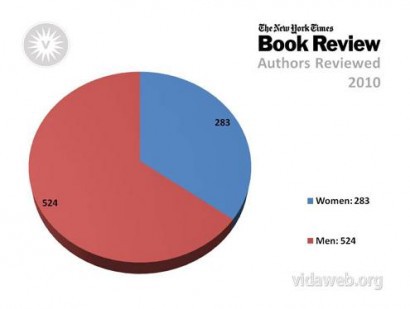
When I think about being female I think about being loved. What I mean by that: I have a little exercise I do when I present my work or speak publicly or even write (like this). In order to build up my courage I try to imagine myself deeply loved. Because there are men whose lives I’ve avidly followed — out of admiration for their work or their “way.” Paolo Pasolini always comes to mind. I love his work, his films, his poetry, his writings on film and literature, his life, all of it, even his death. How did he do it — make such amazing work and stand up so boldly as a queer and a Marxist in a Catholic country in the face of so much (as his violent death proved) hate. I have one clear answer. He was loved. Pasolini’s mother was wild about him. We joke about this syndrome — Oh she was an Italian mother, but she could just have well been a Jewish mother, an Irish mother, an African-American one. A mother loves her son. And so does a country. And that is much to count on. So I try to conjure that for myself particularly when I’m writing or saying something that seems both vulnerable and important so I don’t have to be defending myself so hard. I try and act like its mine. The culture. That I’m its beloved son. It’s not an impossible conceit. But it’s hard. Because a woman, reflexively, often feels unloved. When I saw the recent Vida pie charts that showed how low the numbers are of female writers getting reviewed in the mainstream press I just wasn’t surprised at all though I did cringe. When you see your oldest fears reflected back at you in the hard bright light of day it doesn’t feel good. Because a woman is someone who grew up observing that a whole lot more was being imagined by everyone for her brother and the boys around her in school. If she’s a talented artist she’s told that she could probably teach art to children when she grows up and then she hears the boy who’s good in art get told by the same teacher that one day he could grow up to be a commercial artist. The adult doing the talking in these kinds of exchanges is most often female. And the woman who is still a child begins to wonder if her childhood is already gone because she has been already replaced in the future by a woman who will be teaching children like herself. And will she tell them that they too will not so much fail but vanish before their lives can even begin. These pie charts don’t surprise me. They just demonstrate that a lot of us can easily become just a few of us or even just one of us. I am mildly curious about whether the situation in book reviewing (or even publishing) was actually better for a while during and right after the 70s, the heyday of feminism, but you know I’m not that curious. That thrilling rise then dogged fall would only underline the sad fact that the increased interest in women’s writings for a decade or so was a kind of fleeting impulse, like the interest-in-incest moment, just “a thing,” not a deep cultural shift like the comprehension that slavery or human sacrifice are wrong and we just won’t ever go there again. But to have such a deep sea change in a culture and keep it you have put the reins of its institutions permanently in other hands and let them stay there. “They” would have to have become “you.” And you (whether you were male or female) would have long concluded that women’s writing is either just writing or no different than men’s or equally interesting, or even better. And that perspective would by now be so embedded in our cultural sense of self that the Times or Harpers or The New York Review of Books would no more likely to be short changing women’s books today anymore than they would pull quietly away from reviewing books written in English in order to uphold a belief that the only good work being written today is by African, South American or Icelandic authors. And think nobody would notice. Reasonable people of course would smile and insist that the NYRB be renamed The New York Review of African Books or South American Books or Icelandic. It would have to happen, the NYRB would have to own their bias eventually, what they were doing, the editor would have to issue a statement or else the publication would become a total joke. But to publish a review today that purportedly reviews “all” books yet in fact is dedicated to the project of mainly reviewing men’s without acknowledging that kind of bias sort of begs the question — the operating presumption must be that “we” “all know” that men’s writing is in fact better or more important than women’s — is the real deal and the only thing disputing this is feminism and since that’s “over” (phew) we are back to business as usual. When I say business I mean that there’s just a whole lot of money talking. That’s what’s going on. The more culturally generous moment we’re all missing (whether it ever truly happened or not) was tied to a booming economy. Men weren’t actually sharing space in the 70s and 80s — the doors just got a little wider for a while. And now that there’s less money to go around in book publishing and the surrounding media it seems like what’s getting shoved out is women. That’s what I believe is happening, don’t you. I think we can do this, right? The editor might ask his staff holding up the cover of the next great all-male issue that dare not speak its name — and his staff probably includes a few females and queers — who want to be in on “the conversation.” Who could blame them for that? Well I can. Can’t you? I mean what are we doing here after all.
Is writing just a job. Writing books, writing poems. If it is then the message to women is to go elsewhere. But they can go to hell — these messengers, the collective whoever or whatever that is saying it. I don’t believe that this is a job. I think writing is a passion. It’s an urge as deep as life itself. It’s sex. It’s being and becoming. If you write, then writing is how you know. And when someone starts slowly removing women from of the public reflection of this fact they are saying that she doesn’t know. Or I don’t care if she thinks she knows. She is not a safe bet. Interestingly the poetry world is getting celebrated for its VIDA showing of nearly equal gender parity in reviewing etc. The problem there though is that the majority of the poets writing are female. It’s true. That’s who takes workshops, that’s who gets MFAs, you can easily get some numbers there and frankly in the poetry scene the women are the ones who are generally doing the most exciting work. Why? Because the female reality is still largely unknown. And language is the thrill that holds the unknown in its vague and shifting ways. That’s writing. But despite the fact that there are more females in the poetry world, more females writing their accounts somehow only a fraction of them are able to bob to top of the heap. So the poetry world is in effect performing a kind of affirmative action for men by giving their work a big push ahead, celebrating men’s books at a much higher ratio to the amount and quality of work actually being produced. And I’m not entertaining for a moment that this is because male work is better. I’m female and I don’t so much think female work is better. Female reality is not better. But female reality has consumed male reality abundantly — we have to in order just to survive so female reality always contains male and female. That seems interesting as hell so at the very least I think it’s a lot more interesting than a monotonous male reality. Which seems just sort of staid and old. Tapped out. Female reality (and this goes for all the “other” realities as well — queer, black, trans — everyone else) is more interesting because it is wider, more representative of humanity — it’s definitely more stylistically various because of all it has to carry and show. After all, style is practical. You do different things because you are different. Women are different. Maybe not the women who routinely get invited to take part in the men’s monolith. They are another item. But women as a class are different. That’s how I dispense with the quality question.
But here’s the actual problem. If the poetry world celebrated its female stars at the true level of their productivity and influence poetry would wind up being a largely female world and the men would leave. Poetry would not seem to be the job for them. I think that’s the fear. Losing daddy again! Plus women always need to support, I mean actively support male work in order to dispense with the revolting suggestion that they are feminists. I supported Hillary Clinton with my vote but did you notice she wasn’t really a feminist until she was losing. Well what does feminism mean? Well I think it means that you don’t do much in your work except complain about injustice and describe the personal sphere and talk in a wide variety of ways about labias. You think I’m kidding. Cause I actually do that in my most recent novel — I thought well women in the art world are always celebrating their labias so maybe I should do that in writing. What a great, funny, even masculine idea. To use the pussy as material. So I wrote five pages of pussy wallpaper and gave it to the editors at VICE who did publish it but confided in me that the money people really had to be convinced that it was not entirely disgusting. With all the dirty and violent and racist things that VICE has done, this was um a little troubling. Do we really want to send that kind of message to our readers. What kind of message is that. I guess a wet hairy soft female one. I mean a big giant female hole you might fall into never to be heard from again. I mean and there’s just always a danger if you’re a feminist that you’re also a lesbian (I am) and the only way to really make it clear that you are not that (or that “it” means nothing) is to firmly vote with the guys, kid with them, and be willing to laugh at other women (to demonstrate that you have “a sense of humor”) and not push too hard to include women in anything. Speaking frankly as a lesbian I have to say that the salient fact about the danger zone I call home is the persistent experience of witnessing the quick revulsion of people who believe that because I love women I am a bottom feeder. I am desperately running towards what anyone in their right mind would be running away from. Which is femaleness, which is failure.
And one does after all want to be read as a man. As a man who is a woman perhaps. Can’t we just all be men and some have these genitals and some have those. I heard that that’s how they saw it in the middle ages. And some died after having thirteen children and some just got another wife. Women finally are all replaceable and that’s the real truth. The more different we get the less likely we can fit our foot in the tiny shoe. And that’s the gig. Not being female, but being small. But I want to be loved because I am. That’s all.

Eileen Myles is the author, most recently, of Inferno: A Poet’s Novel, available from OR Books. Her books of poetry include Not Me, School of Fish and Sorry, Tree; other books include Chelsea Girls and Cool for You.
American Foreign Policy Reaping Benefits Of Dumb Luck
“In other words, for all its many missteps of the past two decades, America is remarkably well placed to win the war of ideas now unfolding in the Middle East. This is not because Arabs are fond of America. Most aren’t, right now. But thanks to globalisation, education, satellite television and the palpable failure of the local alternatives, most Arabs (and Iranians) are fully aware of what sort of societies the Western democracies are, and they would like some of the same fresh air for themselves. Is America less powerful today than when its pilots were shooting up Saddam’s Republican Guard on the highway out of Kuwait 20 years ago? It has certainly learnt the hard way that it cannot shape the Middle East just as it wants. But its power of example remains strong in an Arab world whose people want most of all just to breathe free.”
— How America wins wars of ideas now: Support despots who govern in direct opposition to our ideas. Abandon many of those ideas ourselves. Wait a few years.
Fire: Actress, Model-And "Boxing Diva" Who Wasn't
by Hamilton Nolan
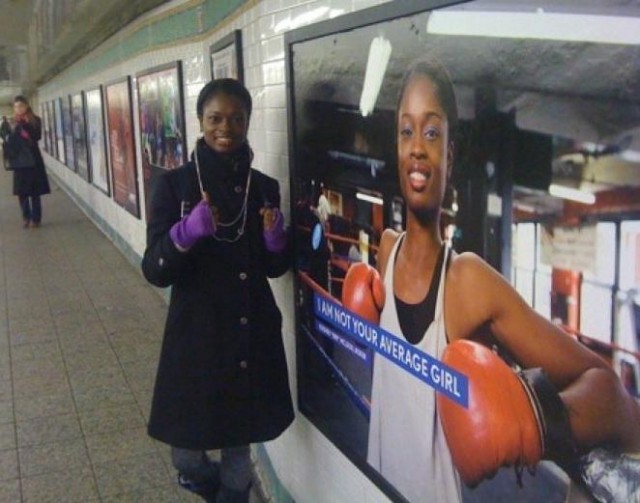
Everyone calls Keisher McLeod-Wells “Fire” — or, more formally, “Fire the Boxing Diva.” That second one is a bit of marketing hype, though, as she’s generally very un-diva-like, and can often be found working the front desk at Gleason’s Gym, perched behind an old desk from some long-forgotten school.
Fire is a rare species: the professional boxer-model-actress. The acting and modeling came first. She’s 33, and she’s been boxing since 2002, when she wandered into the gym after her agent suggested to her that she’d have a better shot landing a role in Terminator: 3 if she got some muscle on her arms like Linda Hamilton. And boxing just seemed like a natural, for that, though she was “not a boxing fan” at the time. A year later, she had her first amateur title; now she’s a pro. She says that the novelty of her boxing career has helped her land modeling gigs (you can catch her plastered all over the New York City subway system right now in ads for NBC New York, bearing the slogan “I am not your average girl.” NBC didn’t pay her for that one, she noted, a little ruefully). In this sense, she is luckier than the average mono-careerist schlub: she can pursue acting, modeling and boxing, and pick whichever one works out best: “Right now,” she said, “it’s boxing.” Fighting, with fists, for money, has proven to be easier than making a fortune at modeling.
Fire’s style, appropriately, does not involve slugging it out until one girl or the other drops with a newly misshapen face. She’s all long arms and legs, sticking and moving, using her reach and speed. She had her fifth pro fight on February 9th at B.B. King’s, in the heart of Times Square. Hers was the sixth fight on a nine-fight card, and the only female bout. That’s good; only three fights were judged to be bigger than hers. Equality creeps into our nation’s most testosteroned corners, slowly but surely.
The night began with Allan “El Mexicano” Benitez’s pro debut, which was ruined — sombrero and all — by Newark’s Joseliz Cepeda, who found the following holes in young Allan’s defense: the right to the body, and the right over the top to the head; and, in the later rounds, also the left to the body, and the left to the head. Once Benitez takes care of those flaws, who knows how far he could go?
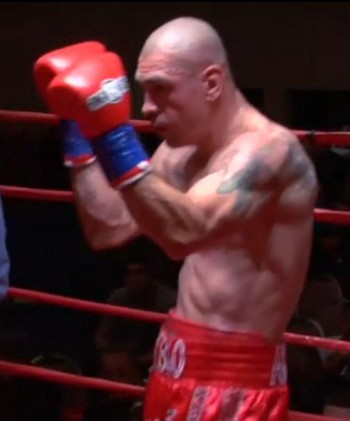
California’s Ishwar Amador brought a ton of fearsome accoutrements into the ring with him: his nickname, “El Diablo”; a fierce red-spangled devilish hoodie to match; and cornermen sporting t-shirts from “Capital Punishment Boxing Club,” which seems like a harsh brand, even by boxing club standards. When the announcer read his name he held up his arms in a fearsome “X” symbol. His opponent, Steven Martinez, was completely guileless, skinny in plain blue trunks, a downright nice-looking kid, who knocked out El Diablo one minute and eleven seconds into the first round with a hook-right-hook that pounded the consciousness out of him sequentially, so that after the last punch his eyes went glassy, and his body slumped, in what I imagine is the same way someone acts when they die.
Deano “Badnewz” Burrell, half of a London-born pair of twins that have moved to Brooklyn to pursue boxing careers (and, like Fire, train at Gleason’s), was up next, with his second pro fight. The way these things usually work is, the prospect (Deano) is eased into his career with ten or fifteen easy fights that he’s bound to win, which get progressively more challenging (though not challenging enough to actually lose), until his record is gaudy enough to earn him a shot with a big-name fighter. The way the thing worked on this night was that Burrell was matched up with Sidell Blocker, whose 0–3 record marked him as an easy opponent, but whose egregiously long arms and awkward style marked him as possible trouble.
Blocker’s reach was his salvation. He was clearly the inferior fighter, but his arms were so long that, even though Burrell was able to slip most of his gawky, swinging punches, he ended up so far away that Blocker’s defense was reset by the time Burrell could step back in range to counter. And even though Blocker whiffed on about four out of five of his big hooks, every fifth one landed. In the first round, Burrell caught one that bruised his right eye, and got mad. He started rushing in, off balance, throwing big overhands, trying to take Blocker’s head off. As a consequence, he went down in the first round, and again in the second, both times less a “knock down” than a case of his body getting away from his legs. Burrell, raging, kept loading up on his punches, which served to make them slower, which served to make Blocker look more competitive than he actually was. In the end Blocker won a disappointing decision. Burrell will be fine, as long as his managers line him up some normal, wildly inferior opponents who aren’t long-armed enough to keep him out of punching range.

The act that Fire had to follow was Boyd Melson, a thoroughly mediocre fighter but enough of an Inspirational Good Guy to make you sick. Not to go into his whole damn story, but he was an Army veteran and after his fight was over he gave a speech urging everyone in the crowd to donate to spinal injury research, name-checking his wheelchair-bound friend in the crowd while surrounded by more than a dozen West Point cadets. I mean, man: talk about poisoning the well of bloodlust. The only notable thing about Melson’s fight was a stern-looking man who I assume was his father (or Father Figure) who kept barking out combo sequences for Boyd to throw during the rounds: “2–3–2! 4–6!” As if he could seamlessly listen, mentally translate those numbers into punches, throw them properly, and score a K.O., thanks to the hollering guy at ringside. (He couldn’t; he was busy being in a fight.) Boxing has stage dads too, apparently.
Fire came out in a gold tank top and miniskirt-looking trunks with a red belt, for the full Wonder Woman effect. Her opponent was “Mighty” Melissa McMorrow, a five-foot-nothing fireplug from California with cornrow braids and a Tysonesque pugnacity. The fight was as straightforward as it gets: tall vs. short. Outside vs. inside. Reach vs. power. If Fire could move, stay away and use her reach, she’d win; if McMorrow could go low, get inside and bang hard, she’d win.
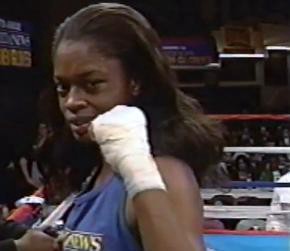
Reach in boxing is what height is in basketball. It’s a natural advantage, a factor that will, all other things being equal, allow one fighter to beat another. It’s not impossible to overcome by any means; there’s a long and proud tradition of short boxers with short arms. There are a few different ways to beat someone with a longer reach than you. You can duck low under their shots and weave your way in, pop up inside, right under their chin, and suddenly their long arms are a disadvantage, being that you’re so close and all; you can time them, slipping their long punches and then shooting inside, hitting them, and pulling back out of range; or, if you’re of a certain punchy disposition, you can just walk through their punches, taking what they have in order to get close enough to hit them yourself.
But in every contest in which one fighter has a longer reach, there is a zone, a certain box of space between the two fighters, in which the fighter with the longer reach can hit the opponent, while the opponent cannot reach them. Smart fighters with long arms, therefore, endeavor to keep their opponent in this space constantly — they punch, and move back, allowing the opponent to always be moving forward into that free fire zone; smart fighters with short arms endeavor to only be outside that space (farther away) or inside it (closer), but never to spend much time in it.
The drawback faced by the taller fighter, though, is that they end up punching down at their opponent, and downward punches are weak, because you can’t put your legs into a punch that’s traveling down. (Try it.) Fire spent the first two rounds doing exactly this at McMorrow, and the shorter girl did manage to rush inside and smack Fire repeatedly with overhands to the face. But in the third and fourth, Fire found her groove; she pop-popped one-twos to McMorrow’s head as she moved in, then spun away, moving back, keeping her distance. As the rounds progressed, fatigue took hold, and McMorrow’s hands began to drop as she rushed in, making her even easier to hit. She did indeed fight mightily, but after a rough beginning, Fire’s reach and movement won her a unanimous decision.
The only thing missing was some male ring card models, for the sake of equality.
I’d pitched a story about this fight to a magazine; the magazine declined it on the grounds that they didn’t want a story about a girl getting beat up. Fire did not get beat up. But in the next fight, Angel Gonzalez, who looks quite a bit like Radio Raheem from Do The Right Thing, got TKO’ed by Irish Seanie Monaghan. Gonzalez did, in fact, get beat up. When the ref stopped the fight at the end of the third round, he gave an angry, animalistic roar, raging against the man who’d taken away his right to keep trading uppercuts. Gonzalez appeared to have lost a tooth. Or maybe it was already like that.
Previously:
• Boxing Is a Bad Job, Badass
• Douchebag as Role Model: The Case of Paulie Malignaggi
• Five Lessons from the New York Golden Gloves Finals
• The Glorious Racism of Boxing
Hamilton Nolan is the media editor of Gawker.
It Is Really Nice Out, You Should Be There
Um, go outside RIGHT NOW, it is sunny and 55 degrees! Don’t miss out, it’s going to get windy later. Or you can wait for Friday, when it will be in the 60s. Winter is so totally over! There’s no way we’re going to have another storm, I just know it.
The New Landline: What Is VOIP?

Sometimes, like once a day, my house phone rings! It usually rings about six times, and I go from “Ooh, someone’s calling me” to “Oh right, no one is actually calling me” by ring number two. The rest of the rings are just an interruption of key plot points to whatever PBS drama I am watching at the time. That is because I do not pickup my phone. Because no one even has the number. It rings all the time, with phone-spam and fake bill collection agencies and sales pitches disguised as surveys. And the fool is me, because I am actually paying for this annoying non-service. It’s not entirely my fault! The purveyors of the new Voice-Over-Internet phone lines haven’t done a good job explaining them to people like me who grew up with crazy things called “answering machines.” Now I will tell you how we can all save ourselves from the old landline.
Okay so! Your first surprise: it’s not unlikely that you’re already using VOIP and you don’t even know it.
(Sponsored posts are purely editorial content that we are pleased to have presented by a participating sponsor, in this case Intel: My Life Scoop; advertisers do not produce the content.)
The Year Of The 'Tweener
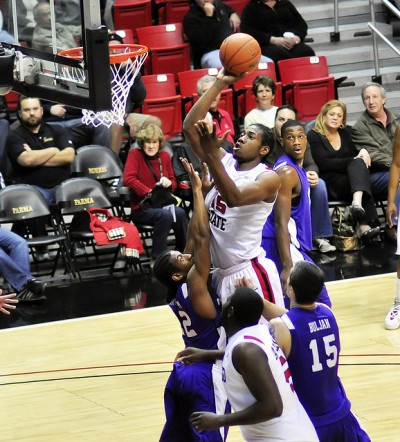
It’s probably true that in this space over the past few months I’ve spent much more time pontificating about obscure French philosophers, junior high science fairs and my own internal angst than I have about actual college basketball this season. OK, it’s definitely true. While I’m confident that some of it has worked, I’ll let you be the judge. And then, like any patriotic American, I will dismiss your judgment until a ruling from a higher court comes through in my favor. Like anyone who’s ever been on stage, when you have an audience that will indulge your love for smashing watermelons with a sledgehammer, you don’t go off and just tell jokes, now do you?
Still, before I give you a 2,500-word allegory for smashing watermelons and how it relates to the coaching situation at Texas Tech (it really does, you know), it occurs to me that tomorrow we are one month from the tip-off of the NCAA tournament, the ultimate conclusion of the entire college basketball season and also the greatest thing ever in the history of the universe. To me, at least. Some people may prefer the World Cup. But these people are principally dangerous subversives.
In thinking about what I should say that is both (a) on topic for a change and (b) not (1) obscurest basketball nerdism or (2) based on some mathematical algorithm that I don’t actually understand and will subsequently have to explain to you so as to make it illustrative, I can with confidence tell you that none of the players you will hear listed this year as Player of the Year candidates in college basketball will be a traditional, near-seven-foot back-to-the-basket center. The reason? This season, there don’t appear to be any.
To be sure, there are plenty of big, tall players and a couple of dominant centers and back-to-the-basket players. The best player on the nation’s best team (Saturday’s upset loss doesn’t change that fact), for example, is Ohio State’s Jared Sullinger], a small house disguised as a college freshman whose ginormous backside elicits regular odes of admiration from grown men. Sullinger plays a punishing inside game, mostly backing his man down using aforementioned rump, sealing his defender off and then laying the ball in when it’s thrown to him a foot and a half from the rim. But Sullinger is in a small group of elite big men this go around. In a year where overall elite NBA-caliber talent appears to be down across college hoops, the most barren area seems to be inside the paint. And this isn’t necessarily a bad thing.
College basketball has, for the better part of a quarter century, been primarily a guard dominated game. Don’t believe me? In the last 15 years, only a three-year stretch from 2003–05 had the Final Four’s Most Outstanding Player at center. Much of this is due to the fact that, during this period, anyone who was at least 6-foot-9, could run and chew gum at the same time or, honestly, just run, was sucked as quickly as possible into the NBA vortex. A few of these guys had stellar one-year showings, like Greg Oden at Ohio State in 2007. But a whole generation of potentially elite collegiate big men never set foot on campus or did it for such a short time that they barely registered. Thus you see NBA box score names that should have but never did appear in collegiate ones like Kendrick Perkins, Amar’e Stoudemire, Al Jefferson and Dwight Howard, just to pluck a few notable ones out of a hat.
Who knows how many potential Patrick Ewings, Hakeem Olajuwons or David Robinsons we never got to see in the NCAA tournament because they were already getting paid NBA dollars to thumb a Playstation during off-hours and attempt to block out Shaq? We’ll never know. But what we do know is that their absence, or their too-brief presence in some cases, has contributed to a lasting culture of guard-ism in collegiate basketball. That is, as college coaches are certainly always on the lookout for skilled, dominant big men, they have had to structure their offenses around the perimeter to protect their flank from NBA invasion. Some coaches, like Villanova’s Jay Wright, have made an art form of the three-guard offense. Others, like Kentucky’s John Calipari, turn to long, lanky swingmen adept at slashing to the hoop. Either way, the days of the four-surrounding-one offense are mostly over, with rare and notable exceptions.
Recruiting an elite traditional big man is a luxury in college basketball today. There are really only two ways to do it: nab a one-year rent-a-pro or take a chance on a late-blooming sleeper recruit who you hope blossoms into a pro. The former path is almost entirely only accomplished by the top 10 or so elite basketball programs, places that can afford to weather the annual turnover that can decimate a roster and leave a coach without other options. If you’re recruiting for a St. Joseph’s or even a low-tier BCS basketball school like an Auburn, you have to decide whether it’s worth the thousands of dollars and potentially hundreds of hours it takes to beat out the Kentuckys, Dukes, Kansases and the like for a guy who will probably stop going to class come the Ides of March.
With rare exceptions, these guys find it isn’t worth it. Witness how Calipari managed to get DeMarcus Cousins out of Alabama, despite the presence of high-Division 1 programs like Auburn and Alabama in Cousins’ backyard that had several years’ head start. Assuming he was headed to the NBA after one year, the resources involved made no sense. This is just one recent example, and there are many others.
So what do you do if you’re not a blueblood or a destination school? You start cutting down your expectations. This is how many of the best undersized big men end up playing and developing into ace college players. If you can’t get the 6’10” or 6’11” agile behemoth, you start looking for a bullish power forward with post moves or the too-thin kid who grew five inches in the last five months but who runs like he just got new legs (because he basically did). Then you try to teach them what they need to know to succeed in your league and beyond. Even in a basketball-crazed nation, size is still the toughest thing to find. You can train a kid to be quicker, faster or shoot better, but excepting methods of torture, you can’t make him taller.
Hopefully, you guess right, teach well and you end up with a standout interior player other teams passed on and who probably gives you an extra year or two that the NBA prospect would not. Sometimes, you’ll end up with an awkward kid who doesn’t pan out, and even in the good cases, you’re probably waiting a season or two for any payoff. That’s the recruiting biz.
But you may be asking, if it then happens that it’s the rich that get richer with elite centers, then how is good that there aren’t really any this season? In a word: parity.
In a normal year, the big dogs bring their big men to the big dance and — a few fun upsets aside — eventually wear down opponents whose only option is to try and bomb away with shooters. This bombs-away strategy generally only lasts a round, maybe two, before some combination of player fatigue, big-game jitters and the big conference school’s superior athletes win out. This plays out when the smaller, guard-oriented team struggles to maintain such a frantic pace, its shots stop falling as consistently from deep range and, lacking the bulk of the higher-seeded squad, Would-Be Upset U. simply can’t rebound enough of its misses to keep from being sent packing.
But this year, when there seem to be fewer dominant big men at the elite programs than in almost any recent year, there appears to be a special equanimity based on a lack of size in the paint. This is where having an undersized but skilled big man — probably not as hot an NBA prospect but every bit as good a college performer — can be a potential Elite Eight or even Final Four asset.
I briefly discussed the concept of the “Tweener” in a previous post. In that regard, I mixed my metaphors a bit, applying the ‘Tweener tag to what was really a bulked-up small forward. True ‘Tweeners are less likely to be ball-handlers and shooters and are more likely to be 6’5”-6’8” power forwards playing out of position in the paint. Or increasingly, as in the case of San Diego State star Kawhi Leonard, they are big men who can run the floor and still suck in rebounds like a Hoover.
These ‘Tweeners often prove more successful college players than they are in the NBA, where the elite athletes are spread over 30 teams instead of over 300. Additionally, a big body that lacks leaping ability can prove as effective in rebounding and playing interior defense as an athletic but thin player can. In the pros, that big body is invariably jumped over, muscled out or simply never played. Again, there are exceptions, but they are just that. It’s important to note that not all the players discussed herein are ‘Tweeners, and not all the top ‘Tweeners are necessarily covered here.
To bring this whole issue into statistical focus, as of Sunday, only one of the nation’s top 15 rebounders lists at 6’10” or bigger: Norfolk State’s Kyle O’Quinn. The rest are almost all either power forwards or small-school undersized centers, including Augustine Runit, a runty 6’6” freshman center at South Alabama. Sullinger — the best big man in a big conference — is right there, too, at just over 10 boards a game. Contrast that with the NBA’s top 15 rebounders, where just three are under 6’10” (All three are listed at 6’9”). Last year, eight of the top 15 picks in the NBA draft were listed at 6’9” or taller. Not all of these were traditional centers, but all were principally back-to-the-basket offensive players. This year, things will likely be quite different.
But one of the biggest fallacies in college basketball coverage is that NBA talent is an accurate metric of NCAA success. The two levels are fundamentally different, but the blurring of the two has become default analysis for basketball pundits. It’s true that each of the national champions in the modern era has featured at least one and usually more than one future NBA player. But the NCAA tournament is not solely about crowning a champion, at least not to die-hards like me. Some schools this year will probably reach never-attained-in-school-history heights, while others will make a bit of history, even if just for one game. And in looking over the winnowing field of probable or potential NCAA teams, it’s eye opening to see which teams out there possess not just talented scorers in the backcourt, an essential but more readily available resource, but skilled and potentially game-changing post players.
In addition to the biggest names, there are a few big men you may not have heard as much about because they either play in off-the-radar locales or their backsides haven’t earned such big-time acknowledgement yet. And if you’re looking for a few teams that may be good NCAA picks in your bracket, take a look at some of the teams these guys play for.
The Big Boys
• Jared Sullinger, F/C, Ohio State: As mentioned, an emerging choice for national Player of the Year due to his all-around interior abilities. A consensus prep All-American, Sullinger hasn’t skipped a beat at the college level and could be the kind of player to carry a team on his back to the Final Four. Details: 6’9”, 280 lbs., Fr.
• JaJuan Johnson, F/C, Purdue: A consistent scorer and shot-blocker for Big Ten power Purdue, Johnson is the opposite of Sullinger — long and lean. A terrific shooter on the blocks, Johnson has picked up the slack for the Boilermakers, who are without the injured senior leader Robbie Hummel. JJ recently had a seven-game streak of 20 or more points snapped, showing just how effective he has been. Details: 6’10”, 216 lbs., Sr.
• Marcus and Markieff Morris, F/C, Kansas: Having a tough, skilled center is a great thing, and Kansas has the rare luxury of having more than one. Two of those are identical twins. The Morris twins both rebound and score, though Marcus is often considered the more dangerous scorer of the two. Combined with backup Thomas Robinson, the Jayhawks front line is frightening because unlike most teams, they can withstand an off game from a post player (or two). These two are a big reason Kansas will be one of the favorites to cut down the nets in April. Details: Marcus — 6’9”, 235 lbs., Jr. / Markieff — 6’10”, 245 lbs., Jr.
Big Boys with Small Reps
• Kawhi Leonard, F, San Diego State: Saying that Leonard has a small rep is probably grossly misrepresenting what he and his Aztec teammates have accomplished this season, reaching as high as No. 4 in the polls. But Leonard isn’t on TV as much as the guys above him on this list, and while he is a legit All-American candidate, he and SDSU will likely still come into the NCAAs undervalued, despite a lofty ranking. Leonard is a mobile and deceptively athletic big man, and he eats rebounds for lunch. Details: 6’7”, 225 lbs., So.
• Jon Leuer, F, Wisconsin: Like all the Wisconsin big men, Leuer’s most dangerous weapon is his jump shot. A 45% three-point shooter, Leuer is a matchup nightmare for most teams. He’s big enough to get points around the rim and grab rebounds but versatile enough to pull other team’s forwards out to the perimeter. As a senior, Leuer’s leadership is hard to quantify. He’s seen a lot of action in the Big Ten over the last four years, and that will prove invaluable for the Badgers in the tournament. Details: 6’10”, 230 lbs., Sr.
• Trey Thompkins, F, Georgia: A classic example of the versatile ‘Tweener, Thompkins bypassed a jump to the NBA for a chance to return Georgia to the NCAA tournament after a long absence. The Bulldogs have work to do after some frustrating losses in close games in a tough SEC East, but if they can get to the Big Dance, Thompkins will be a big reason they could make a surprise run. A capable if erratic shooter to 22 feet and an intimidating defender, Thompkins won’t jump over anyone but you won’t move him off the block. He can put up 17 and 11 without breaking a sweat. Details: 6’9″, 247 lbs., Jr.
Under-known Over-achievers
• Keith Benson, C, Oakland: From the Summit League’s best team comes one of the nation’s best centers. Benson has been getting better for three straight years and has emerged as a legit NBA prospect as a senior. Long and playing the game with a high energy, Benson could be the kind of player that some of the lower-seeded BCS schools have no matchup for, especially in a season with such a dearth of big men. Just ask Tennessee, who saw him drop 26 and 10 in a loss to Oakland at home. But first, Oakland has to get to the Big Dance. Details: 6’11”, 225 lbs., Sr.
• Jamie Skeen, F/C, Virginia Commonwealth: Like Benson, Skeen plies his trade at a mid-major level, but he’s done so at a high level all year. VCU beat UCLA in the fall, but will be sweating on Selection Sunday unless they can earn the CAA automatic bid. Bulky and experienced, Skeen will be a handful for any team in the postseason. Details: 6’9”, 240 lbs., Sr.
• Lavoy Allen, C, Temple: Allen was lightly recruited out of high school but has been good since he stepped onto the Temple campus four years ago. He’s a lanky rebounder and has sneaky offensive skills around the rim. Allen hasn’t performed as well as a senior as some expected, but he was coming on strong before being sidelined last weekend by a bum ankle. Assuming his ankle heals, and Temple continues its push to the NCAA tournament, Allen could give some high-profile schools a glimpse of what they missed out on when they overlooked him coming out of high school. Details: 6’9″, 225 lbs., Sr.
While there’s no guarantee any of the guys listed above will perform on the biggest stage, all have the kind of toughness, hard-to-guard game and take-over capabilities that make for tough outs come March. That nearly all are not traditional seven-foot giants is reason to expect that this year’s NCAA tournament will offer some surprises and a few breakout stars. Expect that the Final Four will feature teams that have the ability play inside-out as well as outside-in, and any of the players I’ve highlighted above could be household names come Final Four weekend in the Year of the ‘Tweener.
Originally from Kentucky, JL Weill now writes from Washington, DC. His take on politics, culture and sports can be found at The New Deterrence and on Twitter.
Photo by SD Dirk, from Twitter.
Woman Saves Husband From Tiger
“I was terrified and I used all my strength to punch the animal in the face, but it would not budge. I had to wrestle with it to keep its jaws away from me, and it would have clawed me to death if my wife had not arrived.”
— It’s a great day for Malaysian couple Tambun Gediu and Han Besau. Gediu was squirrel hunting in the jungle near his home in the northern state of Perak when he was attacked by a tiger. Hearing his screams, Besau ran out of the kitchen and beat the ferocious beast with a wooden soup ladle until it ran away. Gediu is in the hospital, recovering from lacerations. And I’ll bet they don’t even celebrate stupid Valentine’s Day in their village.
High School Love: A Short Graphic Tale About Valentine's Day
by MariNaomi
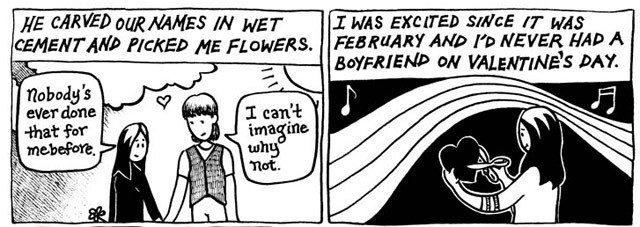
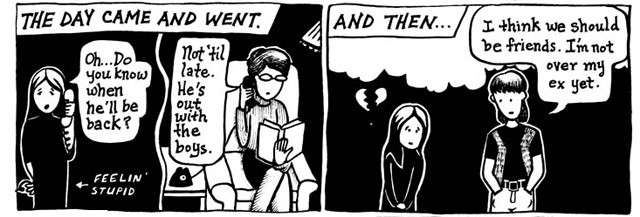
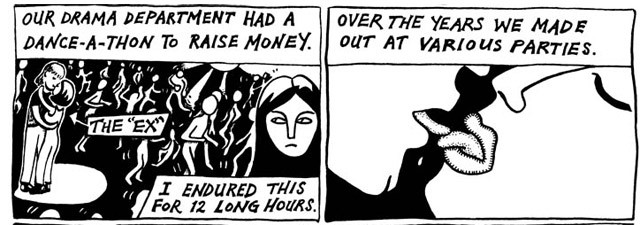
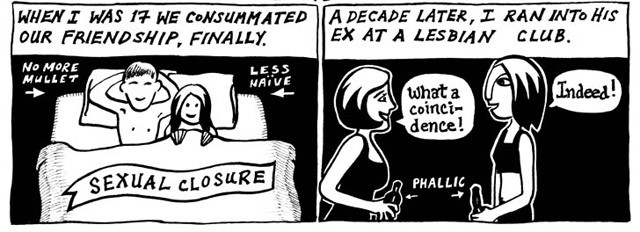
MariNaomi’s graphic novel Kiss & Tell: A Romantic Resume, Ages 0 to 22, will be published next month by HarperCollins. She is an artist and writer who was born in Texas and raised on the West Coast. Her work has appeared in such publications as The Comics Journal, Not My Small Diary and Action Girl. She believes in animal rights, following one’s dreams and that nice guys and gals always deserve a shot. She lives with her husband and small entourage of animal friends in San Francisco, California.
Today's Aww: Baby Polar Bear
Would you like to see pictures of an adorable baby polar bear? Is it Monday? Of course you would. Step this way, please.
The Realness: Arcade Fire, Nixon in China, Odd Future, Clapping Music, Tahrir Square
The Realness: Arcade Fire, Nixon in China, Odd Future, Clapping Music, Tahrir Square
by Seth Colter Walls

Since I had no economic imperative to do so and am talented at time-management, I decided against committing to the 3+ hour telecast of last night’s Grammy Awards — going instead with breaking news absorption through Twitter, along with watching a few relevant performances (Janelle Monae and Arcade Fire) via our janky, insta-uploaded-to-YouTube commons.
But that doesn’t mean I didn’t walk through the New York City subway system these last few weeks. “MUSICisLIFEisMUSIC,” went the Recording Academy’s halfway inspiring but also inescapably vapid manner of posterboard tautology. That toothache you can’t get looked at without dental insurance? Oh, well, that’s life — which is to say, music! So be sure to enter your gaping recessional cavity into the “Best Wince-Inducing Pain of the Year” category during the next nomination window. (You will lose to the Peas.)
As David Shields would argue, our hunger for art is currently doubled over at veracity’s door, begging for entry and access to the real. But co-opting the real with entertainment isn’t media’s only option: cultural fakery is a force which can birth its own “truth.” So there’s no point in being upset when the climax of Arcade Fire’s ebullient post-Album of the Year performance of “Ready to Start” was interrupted by an ad for Hilton hotels, interpolated courtesy of the DJs in the telecast control room — presumably contractually bound right up to the final seconds.”Businessmen drink my blood,” for real. A line in the made-up song was made real, though not on the stage where it was being performed for a crowd that couldn’t tell how the home audience saw it. The line only became real for the people watching on television. Still — for the kids in art school who warned Arcade Fire that this would happen — Kanye West was right about the emotional undercurrent of their award.
RT @ArcadeFireNews: RT @kanyewest: #Arcade fire!!!!!!!!!! There is hope!!! I feel like we all won when something like this happens! F …Mon Feb 14 08:25:02 via Echofon
Stewart Brown
stewbrown
Well, at least before he apparently deleted the relevant Tweet. (For being too real?) Still, the Merge Records outfit’s win over much bigger promotional muscles was to some degree a hope-conferring thing.
The oddity of media being overrun by history while you’re also making it has also been a tertiary feature of the much-more-consequential Egyptian Revolution. Those kids in Tahrir — while still subject to and bound by the lack of historical precedent when it comes to democratic transitions mediated by militaries in West Asia — nevertheless made something new. And they did it on the backs of what otherwise seemed like an absolute truth, flowing from Newton’s first law regarding strongman longevity.
https://www.youtube.com/watch?v=fNNFnj-pNik
Or else we could put it like this: “And every word, transforming us / As we, transfixed — made history.”
That’s a line of poetry spoken by a faux-President Nixon, upon landing in Communist China, during the first act of an opera currently playing at the Met in New York (as well as on these movie screens across the U.S. on March 2nd). Slightly upsetting yet not unexpected is how much the point of the opera “Nixon in China” has been missed in some corners of the specialist and elite press. In the Times last week, erstwhile executive editor Max Frankel — who covered Nixon’s real trip in ‘72 — waxed concern-trollic over the potential for art responding to very recent history to make us confused. “[By] appropriating and embellishing a recognizable history, the art may end up straining our credulity,” Frankel wrote. (About opera! Straining our credulity! Gambling in this casino!)
This shocking audience condescension — the idea that we’re unable to interpret real-life references that work both as signifiers and as something more mythic than the narrow historical particulars — found a strange bedfellow in the Observer’s Zachary Woolfe, who wrote: “In 1987, rendering Nixon as less malevolent than thoughtful, confused and lonely was provocative. But today the fact of Nixon as human is taken largely for granted, so the success of the piece in 2011 depends more on the things that always matter in opera: the production, the words, the music.”
Woolfe then went on to note several problems with the music and production on a bumpy opening night. (Many of which, at least to my eyes and ears have been adressed in the weeks since Nixon’s premiere.) But even on an imperfect opening night, I was not thinking just of orchestral balance, but of Egypt’s President Mubarak, who looked like he might have to repair to Sharm el-Sheikh (as has since happened). I was thinking about how, as Mao says in the opera, “founders come first, then profiteers.” Or how Madame Mao’s clever line break in her first aria (“When I appear, the people hang / upon my words”) seemed prescient during the pro-government thugs’ attempted siege on Tahrir.
It’s frustrating how inflexible classical music’s relationship with the media can be, relative to how pop and indie manage to behave. If those vernacular forms show an ever-increasing ability to ride the wave of post-millennial information overload, though, that doesn’t mean that some in the classical world have given up the pop-accessible ghost entirely, as this Angie Dickinson-Lee Marvin piece of video-collage (from the movie Point Blank) illustrates.
https://www.youtube.com/watch?v=BY4bL_bO8sA
Minimalism’s reach is also identifiable in the new single from Tyler, the Creator (the leader of the sensationally misogynistic Odd Future Wolf Gang Kill Them All collective). I’ve never been quite offended by the group, if only because their conceptual purpose seems so much more purposeful than pop stars who are supposedly “batshit crazy” for palling around with Armani, stylistically.
Tyler’s best line so far — from the title track to last year’s self-released album “Bastard” — was “Fuck a deal, I just want my father’s email / So I can tell him how much I fucking hate him in detail.” In an album rife with personas and unreliable narrators, it came across as fictionally 100% true. The opening line of the new joint, “Yonkers,” approaches that level with its opening couplet, which in high meta-fashion pillories artists who like to come across as more complex than they are. “I’m a fuckin’ walkin’ paradox / No I’m not.”
https://www.youtube.com/watch?v=XSbZidsgMfw
Seth Colter Walls has a day job and a Tumblr both!
